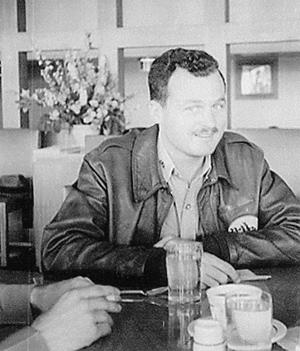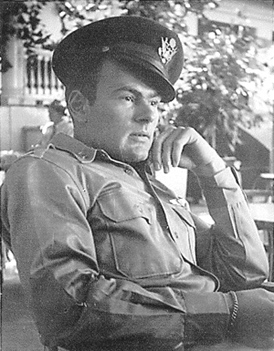|
B-26 No. 40-1441 "Tactless Texan" Crew 1942
Flight crew
Pilot: 2nd Lt. Fletcher M. Glenn
Co-pilot: 2nd Lt. George Spaulding
Bombardier-nose gunner ?
Navigator: 2nd Lt. David S. Nelson
Engineer-tail gunner: PFC William J. Rohler
Radio operator: ?
Turret gunner: ?
Crew Chief: Sgt. George Rehklau
At this distance of 65 years I can not remember the names
of the fine
men who made up the rest of my crew.
I graduated from Kelly Field, Texas, in the class of 40E as a second
lieutenant with an "Airplane pilot" rating.
The summer of 1941 found me at Patterson Field near Dayton, Ohio, teaching
Russian pilots how to fly the B-26s which we were giving them under
President Franklin D. Roosevelt's Lend-Lease program. With the Lend-Lease
program we manufactured the goods and "loaned" them to Britain and her
allies. In case you don't remember the day and hour, we were soon to be
allied with the Russians as well as Great Britain and a number of other
countries against the German Nazis and were providing these allies with
war materiel. One of the other U.S. pilots helping out with the project
was 2nd Lt. Lewis Ford who remembers the project very well.
It was not the easiest thing I have ever done because we had to work with
the Russian pilots through an interpreter and communicating an emergency
through a third party can be pretty hairy. Airplanes can be very
unforgiving. The B-26 had disk brakes for the pilot seat only which
provided absolute control of the airplane for taxiing at high speed. The
co-pilot has no brakes and the co-pilot's rudder folds out of the way to
gain access to the bombardier's station. Because of this restriction and
the difficulty of communication the Russian pilots actually spent very
little in the pilot's seat.
We ferried planes from the Glenn Martin plant in Baltimore, Maryland, took
them via Amarillo, Texas, to McClellan Field in Sacramento, California,
where they were taken later and turned over to the Russians via a
circuitous route through Alaska and Vladivostok to the Russians. Ted Ford
has a picture of one of these B-26s flying on his wing with absolutely no
identifying markings on the plane at all.
I was back at Langley Field, Virginia, on December 7th, 1941, when the
Japanese attacked Pearl Harbor. The very next day, December 8th we packed
up our gear on our B-26 and took off via Randolph Field, Texas, El Paso,
Texas, to Muroc, California, an old dried up lake bed and then to March
Field. At that time there were less than 2,000 military pilots in the
United States with experience senior to me, then age 22.
Responsibility and lots of it came very fast.
We lingered in California because the Californians were sure that they
would be the next target and didn't want us to leave them unprotected. We
flew coastal patrols until the end of January when we departed San
Francisco with our crated airplanes on a ship headed for Honolulu. By the
end of February our planes had been uncrated and reassembled.
|

1st Lt. William A Garnett
First Pilot |

2nd Lt. Allen H. Hutchinson
Fletcher's first co-pilot as far as Honolulu |
| |
|
|

2 - B26's |

Three unknowns and Hutchinson |
We spent most of March flight testing them and then on March 25th a
flight of 56 airplanes, B-26 bombers, carrying 392 men left for Brisbane,
three or four planes at a time to spread the risk, to join MacArthur's
defense of Australia. It was a dangerous trip using only Capt. Cook's old
maps for navigation of the vast expanse of the Pacific. But we had a fine
navigator in 2nd Lt. David Nelson and he got us where we wanted to go in
fine style. We island hopped first to Palmyra Island which is really tiny,
Canton Island, Nandi in Fiji, New Caledonia and then to Amberly Field in
Brisbane.
MacArthur now had 72 airplanes and went back to war. Twenty three days
later there very few first pilots alive among the 56 who had left
Honolulu. I recall the intensity of those 23 days of living so fast and
perilously moment by moment as something that can be brought back only in
disconnected segments, like a bad dream. Being so busy just trying to make
important decisions from minute to minute, one loses track of other
serious matters and there were times of being embarrassed that one can't
remember who is still alive and who was killed where and how. The things
that stick in the memory are the little things.
One vivid image that never goes away began about 10:00 a.m. taking a
flight of B-26's from Port Moresby, New Guinea, to bomb the airport at
Rabaul, New Britain. The weather there was down so close to the ground
that immediately after the bomb run the formation broke up because of the
reduced visibility. Automatically, emergency separation procedures to
avoid collision in the clouds went into effect, but that meant that each
bomber started back home as a solitary target for enemy fighters. The
distance was 900 miles and the first 600 of those miles was over water.
Radio silence was broken by a plane in distress announcing that he was
going down on the beach only a few miles from the airport they had just
bombed. He reported that enemy fire had jammed his bomb bay doors open and
stopped his right engine. This was considered insurmountable trouble. The
plane could fly on one engine indefinitely, but it was not designed to do
that with two doors open!
We dropped down through the clouds for a look and miraculously drifted
into a perfect intercept. Closing up to confirm, we could see that the
cripple was indeed not very airworthy. We took up a position to monitor
the crash landing so that no fighters could complicate matters further.
And then radio silence was broken again. The wounded bird wanted to know,
"If I try to make it, will you stick with me and report my location if I
don't make it?" I replied in the affirmative with a silent visual signal
because he was only 25 feet away, but it was a solemn commitment of seven
men to seven other men to be seriously considered and re-considered as the
afternoon wore on.
During the next hour it became evident that the disabled plane was not
holding its altitude and the pathetic process began of throwing weight
over board - - first ammunition, guns, the celebrated Norden bombsight,
anything loose. And still the plane got lower and slower. It got so low
that you thought that each next wave would be the one to get her, only to
miss it by seemingly less than 10 feet. It was going so slowly by now that
I dared not go that slow for fear of stalling my own plane and the only
way that I was able to remain behind the other B-26 was by zigzagging to
consume the extra miles per hour necessary to safeguard against a double
tragedy.
Every minute or two something more came out of those open bomb doors. Six
men were, with calm desperation, pulling things loose that can't come
loose, but their lives were hanging in the balance and they didn't intend
to lose that contest. In the next hour everything imaginable same out, and
slowly, quietly, it became almost believable that stability had been
achieved. The weight of its fuel load had been burning away also and the
plane had gained back up to 50 feet of altitude. No one dared celebrate
for there were two more hours of never being sure, but the landfall was
made and the crew walked away from a crash landing in the surf of New
Guinea.
On April 22, 1942, we took our B-26, the "Tactless Texan", on a bombing
raid to Rabaul but on the way had to land in Port Moresby with a burned
out generator. As you know the prop pitch on a B-26 depends on electricity
so we had to get a new one. Another plane crashed and it took us about 20
seconds to cannibalize its generator. We were on the wing of our B-26
changing it out when somebody yelled "air raid' which meant "there they
are!" (We had no radar in those days.) I jumped off the wing and headed
for a slit trench but failed to make it before a jagged piece of shrapnel
screwed into my thigh and the war was over for me.
They took me up into the mountains above Port Moresby where a kindly Dutch
doctor dug out the shrapnel. The United States sent in a plane to pick me
up. It rolled to a stop at the end of the runway without turning off its
engines, they loaded me aboard and took off immediately heading back to
Australia.
Along with my airplane I lost most of the pictures I had taken along with
my camera and other personal gear.
After about a year in and out of hospitals I was assigned to the
Performance Test Section at Wright Field near Dayton, Ohio, and spent the
rest of the was as a test pilot. This was a little safer than being shot
at but only marginally so. There was a constant complement of 80 test
pilots at all times and the turn over due to accidents was so great that I
could not remember who was alive and who was dead among my fellow pilots.
To give you a good idea of the mortality rate, Air Force aces Don Gentile
and Richard Bong were both killed in the first jet aircraft experimental
flights.
Promotions come rapidly during wartime and I went quickly from 2nd
Lieutenant to 1St Lieutenant, Captain, and finally Major and a Senior
Pilot. Testing airplanes brought about flying and being qualified in a
wide variety of aircraft. I eventually flew 52 different aircraft
including the original research and testing of three versions of
experimental Sikorsky helicopters. I am honored to be a member of the "Twirlybirds"
helicopter pioneers organization.
Aircraft piloted by Fletcher Glenn:
A (Attack): A-17 stealth aircraft, A-20 light bomber, A-29 Lockheed
Hudson, AT-6 Adv. Trainer, AT-7, AT-9 Adv. trainer, AT-11 Kansan, AT-18
Lockheed Hudson, AT 23
Basic Trainers: BT-3, BT-9, BT-13, BT-14, BT-15
Bombers: B-17 Flying Fortress, B-18 Bolo, B-23 Dragon, B-24 Liberator,
B-25 Mitchell, B-26 Marauder, B-29 Super Fortress, B-37
Cargo planes: C-39, C-40 (DC-3), C-45, C-46 Commando, C-47 Skytrain, C-54
Skymaster, C-60, C-78, C-82, C-97 Strato Freighter, CG-14 (glider),
CQ-3-BH
L-5 Flying Jeep
P-40 Warhawk, P-47 Thunderbolt, P-51 Mustang, PB-4-Y Navy bomber, PBM,
4-PQ-12, PQ-14 Cadet, PT-3
SNB-1 Navigator
Experimental helicopters: R-1, R-4, R-6
Total aircraft: 52
Note: The Lockheed Hudson had several versions |